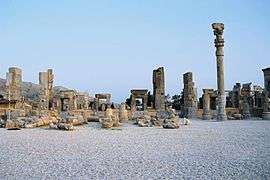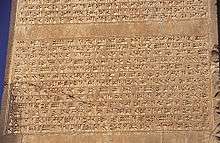Persepolis
Persepolis (/pɝˈsepəlɪs/, Old Persian: 𐎱𐎠𐎼𐎿, Pārsa) was the ceremonial capital of the Achaemenid Empire (ca. 550–330 BC). It is situated 60 kilometres (37 mi) northeast of the city of Shiraz in Fars Province, Iran. The earliest remains of Persepolis date back to 515 BC. It exemplifies the Achaemenid style of architecture. UNESCO declared the ruins of Persepolis a World Heritage Site in 1979.[2]
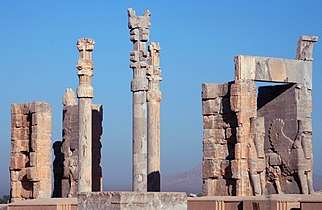 Ruins of the Gate of All Nations, Persepolis. | |
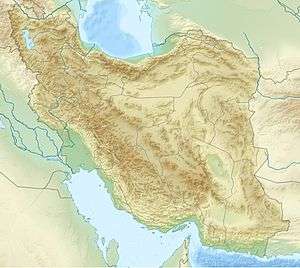 Shown within Iran | |
| Location | Marvdasht, Fars Province, Iran[1] |
|---|---|
| Coordinates | 29°56′04″N 52°53′29″E |
| Type | Settlement |
| History | |
| Builder | Darius the Great, Xerxes the Great and Artaxerxes I |
| Material | Limestone, mud-brick, cedar wood |
| Founded | 6th century BC |
| Periods | Achaemenid Empire |
| Cultures | Persian |
| Events |
|
| Site notes | |
| Condition | in ruins |
| Management | Cultural Heritage, Handicrafts and Tourism Organization of Iran |
| Public access | open |
| Architecture | |
| Architectural styles | Achaemenid |
| Official name | Persepolis |
| Type | Cultural |
| Criteria | i, iii, vi |
| Designated | 1979 (3rd session) |
| Reference no. | 114 |
| State Party | Iran |
| Region | Asia-Pacific |
Name
The English word Persepolis is derived from Ancient Greek: Περσέπολις, romanized: Persepolis, a compound of Pérsēs (Πέρσης) and pólis (πόλις), meaning "the Persian city" or "the city of the Persians". To the ancient Persians, the city was known as Pārsa (Old Persian: 𐎱𐎠𐎼𐎿), which is also the word for the region of Persia.[3][4]
An inscription left in AD 311 by Sasanian prince Shapur Sakanshah, the son of Hormizd II, refers to the site as Sad-stūn, meaning "Hundred Pillars".[5] Because medieval Persians attributed the site to Jamshid,[6] a king from Iranian mythology, it has been referred to as Takht-e-Jamshid (Persian: تخت جمشید, Taxt e Jamšīd; [ˌtæxtedʒæmˈʃiːd]), literally meaning "Throne of Jamshid". Another name given to the site in the medieval period was Čehel Menār, literally meaning "Forty Minarets".[5]
Geography
Persepolis is near the small river Pulvar, which flows into the Kur River.

The site includes a 125,000 square meter terrace, partly artificially constructed and partly cut out of a mountain, with its east side leaning on Rahmat Mountain. The other three sides are formed by retaining walls, which vary in height with the slope of the ground. Rising from 5–13 metres (16–43 feet) on the west side was a double stair. From there, it gently slopes to the top. To create the level terrace, depressions were filled with soil and heavy rocks, which were joined together with metal clips.
History
Archaeological evidence shows that the earliest remains of Persepolis date back to 515 BC. André Godard, the French archaeologist who excavated Persepolis in the early 1930s, believed that it was Cyrus the Great who chose the site of Persepolis, but that it was Darius I who built the terrace and the palaces. Inscriptions on these buildings support the belief that they were constructed by Darius.
With Darius I, the scepter passed to a new branch of the royal house. Persepolis probably became the capital of Persia proper during his reign. However, the city's location in a remote and mountainous region made it an inconvenient residence for the rulers of the empire. The country's true capitals were Susa, Babylon and Ecbatana. This may be why the Greeks were not acquainted with the city until Alexander the Great took and plundered it.
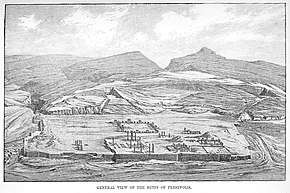
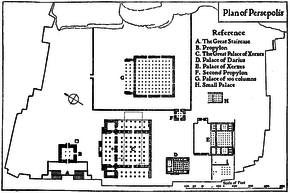
Darius I's construction of Persepolis were carried out parallel to those of the Palace of Susa.[7] According to Gene R. Garthwaite, the Susa Palace served as Darius' model for Persepolis.[8] Darius I ordered the construction of the Apadana and the Council Hall (Tripylon or the "Triple Gate"), as well as the main imperial Treasury and its surroundings. These were completed during the reign of his son, Xerxes I. Further construction of the buildings on the terrace continued until the downfall of the Achaemenid Empire.[9] According to the Encyclopædia Britannica, the Greek historian Ctesias mentioned that Darius I's grave was in a cliff face that could be reached with an apparatus of ropes.[10]
Around 519 BC, construction of a broad stairway was begun. The stairway was initially planned to be the main entrance to the terrace 20 metres (66 feet) above the ground. The dual stairway, known as the Persepolitan Stairway, was built symmetrically on the western side of the Great Wall. The 111 steps measured 6.9 metres (23 feet) wide, with treads of 31 centimetres (12 inches) and rises of 10 centimetres (3.9 inches). Originally, the steps were believed to have been constructed to allow for nobles and royalty to ascend by horseback. New theories, however, suggest that the shallow risers allowed visiting dignitaries to maintain a regal appearance while ascending. The top of the stairways led to a small yard in the north-eastern side of the terrace, opposite the Gate of All Nations.
Grey limestone was the main building material used at Persepolis. After natural rock had been leveled and the depressions filled in, the terrace was prepared. Major tunnels for sewage were dug underground through the rock. A large elevated water storage tank was carved at the eastern foot of the mountain. Professor Olmstead suggested the cistern was constructed at the same time that construction of the towers began.
The uneven plan of the terrace, including the foundation, acted like a castle, whose angled walls enabled its defenders to target any section of the external front. Diodorus Siculus writes that Persepolis had three walls with ramparts, which all had towers to provide a protected space for the defense personnel. The first wall was 7 metres (23 feet) tall, the second, 14 metres (46 feet) and the third wall, which covered all four sides, was 27 metres (89 feet) in height, though no presence of the wall exists in modern times.
Function
The function of Persepolis remains quite unclear. It was not one of the largest cities in Persia, let alone the rest of the empire, but appears to have been a grand ceremonial complex that was only occupied seasonally; it is still not entirely clear where the king's private quarters actually were. Until recent challenges, most archaeologists held that it was especially used for celebrating Nowruz, the Persian New Year, held at the spring equinox, and still an important annual festivity in modern Iran. The Iranian nobility and the tributary parts of the empire came to present gifts to the king, as represented in the stairway reliefs.[11]
Destruction
After invading Achaemenid Persia in 330 BC, Alexander the Great sent the main force of his army to Persepolis by the Royal Road. He stormed the "Persian Gates", a pass through modern-day Zagros Mountains. There Ariobarzanes of Persis successfully ambushed Alexander the Great's army, inflicting heavy casualties. After being held off for 30 days, Alexander the Great outflanked and destroyed the defenders. Ariobarzanes himself was killed either during the battle or during the retreat to Persepolis. Some sources indicate that the Persians were betrayed by a captured tribal chief who showed the Macedonians an alternate path that allowed them to outflank Ariobarzanes in a reversal of Thermopylae. After several months, Alexander allowed his troops to loot Persepolis.
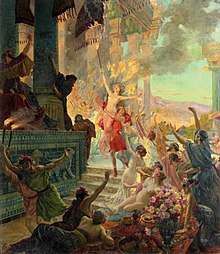
Around that time, a fire burned "the palaces" or "the palace". Scholars agree that this event, described in historic sources, occurred at the ruins that have been now re-identified as Persepolis. From Stolze's investigations, it appears that at least one of these, the castle built by Xerxes I, bears traces of having been destroyed by fire. The locality described by Diodorus Siculus after Cleitarchus corresponds in important particulars with the historic Persepolis, for example, in being supported by the mountain on the east.
It is believed that the fire which destroyed Persepolis started from Hadish Palace, which was the living quarters of Xerxes I, and spread to the rest of the city.[12] It is not clear if the fire was an accident or a deliberate act of revenge for the burning of the Acropolis of Athens during the second Persian invasion of Greece. Many historians argue that, while Alexander's army celebrated with a symposium, they decided to take revenge against the Persians.[13] If that is so, then the destruction of Persepolis could be both an accident and a case of revenge.
The Book of Arda Wiraz, a Zoroastrian work composed in the 3rd or 4th century, describes Persepolis' archives as containing "all the Avesta and Zend, written upon prepared cow-skins, and with gold ink", which were destroyed. Indeed, in his Chronology of the Ancient Nations, the native Iranian writer Biruni indicates unavailability of certain native Iranian historiographical sources in the post-Achaemenid era, especially during the Parthian Empire. He adds: "[Alexander] burned the whole of Persepolis as revenge to the Persians, because it seems the Persian King Xerxes had burnt the Greek City of Athens around 150 years ago. People say that, even at the present time, the traces of fire are visible in some places."[13][14]
Paradoxically, the event that caused the destruction of these texts may have helped in the preservation of the Persepolis Administrative Archives, which might otherwise have been lost over time to natural and man-made events.[15] According to archaeological evidence, the partial burning of Persepolis did not affect what are now referred to as the Persepolis Fortification Archive tablets, but rather may have caused the eventual collapse of the upper part of the northern fortification wall that preserved the tablets until their recovery by the Oriental Institute's archaeologists.[16]
_(cropped).jpg)
After the fall of the Achaemenid Empire
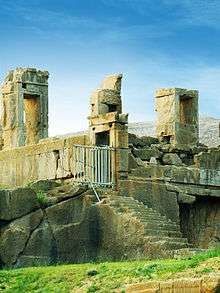
In 316 BC, Persepolis was still the capital of Persia as a province of the great Macedonian Empire (see Diod. xix, 21 seq., 46; probably after Hieronymus of Cardia, who was living about 326). The city must have gradually declined in the course of time. The lower city at the foot of the imperial city might have survived for a longer time;[17] but the ruins of the Achaemenids remained as a witness to its ancient glory. It is probable that the principal town of the country, or at least of the district, was always in this neighborhood.
About 200 BC, the city of Estakhr, five kilometers north of Persepolis, was the seat of the local governors. From there, the foundations of the second great Persian Empire were laid, and there Estakhr acquired special importance as the center of priestly wisdom and orthodoxy. The Sasanian kings have covered the face of the rocks in this neighborhood, and in part even the Achaemenid ruins, with their sculptures and inscriptions. They must themselves have been built largely there, although never on the same scale of magnificence as their ancient predecessors. The Romans knew as little about Estakhr as the Greeks had known about Persepolis, despite the fact that the Sasanians maintained relations for four hundred years, friendly or hostile, with the empire.
At the time of the Muslim invasion of Persia, Estakhr offered a desperate resistance. It was still a place of considerable importance in the first century of Islam, although its greatness was speedily eclipsed by the new metropolis of Shiraz. In the 10th century, Estakhr dwindled to insignificance, as seen from the descriptions of Estakhri, a native (c. 950), and of Al-Muqaddasi (c. 985). During the following centuries, Estakhr gradually declined, until it ceased to exist as a city.
Archaeological research
Odoric of Pordenone may have passed through Persepolis on his way to China in 1320, although he mentioned only a great, ruined city called "Comerum".[18] In 1474, Giosafat Barbaro visited the ruins of Persepolis, which he incorrectly thought were of Jewish origin.[19] Hakluyt's Voyages included a general account of the ruins of Persepolis attributed to an English merchant who visited Iran in 1568.[20][21] António de Gouveia from Portugal wrote about cuneiform inscriptions following his visit in 1602. His report on the ruins of Persepolis was published as part of his Relaçam in 1611.[22]
In 1618, García de Silva Figueroa, King Philip III of Spain's ambassador to the court of Abbas I, the Safavid monarch, was the first Western traveler to link the site known in Iran as "Chehel Minar" as the site known from Classical authors as Persepolis.[23]
Pietro Della Valle visited Persepolis in 1621, and noticed that only 25 of the 72 original columns were still standing, due to either vandalism or natural processes.[24] The Dutch traveler Cornelis de Bruijn visited Persepolis in 1704.[25]
- Sketch of Persepolis from 1704
by Cornelis de Bruijn. - Drawing of Persepolis in 1713
by Gérard Jean-Baptiste. 
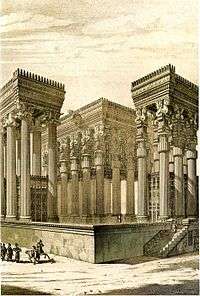 The Apadana by Charles Chipiez.
The Apadana by Charles Chipiez.- Apadana detail by Charles Chipiez.
The fruitful region was covered with villages until its frightful devastation in the 18th century; and even now it is, comparatively speaking, well cultivated. The Castle of Estakhr played a conspicuous part as a strong fortress, several times, during the Muslim period. It was the middlemost and the highest of the three steep crags which rise from the valley of the Kur, at some distance to the west or northwest of the necropolis of Naqsh-e Rustam.
The French voyagers Eugène Flandin and Pascal Coste are among the first to provide not only a literary review of the structure of Persepolis, but also to create some of the best and earliest visual depictions of its structure. In their publications in Paris, in 1881 and 1882, titled Voyages en Perse de MM. Eugene Flanin peintre et Pascal Coste architecte, the authors provided some 350 ground breaking illustrations of Persepolis.[26] French influence and interest in Persia's archaeological findings continued after the accession of Reza Shah, when André Godard became the first director of the archeological service of Iran.[27]
In the 1800s, a variety of amateur digging occurred at the site, in some cases on a large scale.[26]
The first scientific excavations at Persepolis were carried out by Ernst Herzfeld and Erich Schmidt representing the Oriental Institute of the University of Chicago. They conducted excavations for eight seasons, beginning in 1930, and included other nearby sites.[28][29][30][31][32]
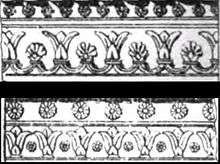
Herzfeld believed that the reasons behind the construction of Persepolis were the need for a majestic atmosphere, a symbol for the empire, and to celebrate special events, especially the Nowruz.[4] For historical reasons, Persepolis was built where the Achaemenid dynasty was founded, although it was not the center of the empire at that time.
Excavations of plaque fragments hint at a scene with a contest between Herakles and Apollo, dubbed A Greek painting at Persepolis.[33]
Architecture
Persepolitan architecture is noted for its use of the Persian column, which was probably based on earlier wooden columns. Architects resorted to stone only when the largest cedars of Lebanon or teak trees of India did not fulfill the required sizes. Column bases and capitals were made of stone, even on wooden shafts, but the existence of wooden capitals is probable. In 518 BC, a large number of the most experienced engineers, architects, and artists from the four corners of the universe were summoned to engage and with participation, build the first building to be a symbol of universal unity and peace and equality for thousands of years.
The buildings at Persepolis include three general groupings: military quarters, the treasury, and the reception halls and occasional houses for the King. Noted structures include the Great Stairway, the Gate of All Nations, the Apadana, the Hall of a Hundred Columns, the Tripylon Hall and the Tachara, the Hadish Palace, the Palace of Artaxerxes III, the Imperial Treasury, the Royal Stables, and the Chariot House.[34]
Ruins and remains
Ruins of a number of colossal buildings exist on the terrace. All are constructed of dark-grey marble. Fifteen of their pillars stand intact. Three more pillars have been re-erected since 1970. Several of the buildings were never finished. F. Stolze has shown that some of the mason's rubbish remains.
So far, more than 30,000 inscriptions have been found from the exploration of Persepolis, which are small and concise in terms of size and text, but they are the most valuable documents of the Achaemenid period. Based on these inscriptions that are currently held in the United States most of the time indicate that during the time of Persepolis, wage earners were paid.
Since the time of Pietro Della Valle, it has been beyond dispute that these ruins represent the Persepolis captured and partly destroyed by Alexander the Great.
Behind the compound at Persepolis, there are three sepulchers hewn out of the rock in the hillside. The facades, one of which is incomplete, are richly decorated with reliefs. About 13 km NNE, on the opposite side of the Pulvar River, rises a perpendicular wall of rock, in which four similar tombs are cut at a considerable height from the bottom of the valley. Modern-day Iranians call this place Naqsh-e Rustam ("Rustam Relief"), from the Sasanian reliefs beneath the opening, which they take to be a representation of the mythical hero Rostam. It may be inferred from the sculptures that the occupants of these seven tombs were kings. An inscription on one of the tombs declares it to be that of Darius I, concerning whom Ctesias relates that his grave was in the face of a rock, and could only be reached by the use of ropes. Ctesias mentions further, with regard to a number of Persian kings, either that their remains were brought "to the Persians," or that they died there.
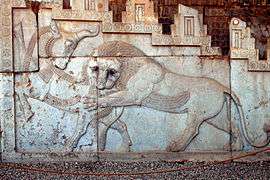
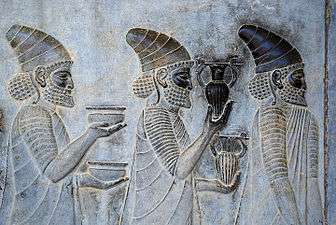
- Achaemenid plaque from Persepolis, kept at the National Museum, Tehran.
 Relief of a Median man at Persepolis.
Relief of a Median man at Persepolis.- Objects from Persepolis kept at the National Museum, Tehran.
Gate of All Nations
The Gate of All Nations, referring to subjects of the empire, consisted of a grand hall that was a square of approximately 25 metres (82 ft) in length, with four columns and its entrance on the Western Wall. There were two more doors, one to the south which opened to the Apadana yard and the other opened onto a long road to the east. Pivoting devices found on the inner corners of all the doors indicate that they were two-leafed doors, probably made of wood and covered with sheets of ornate metal.
A pair of lamassus, bulls with the heads of bearded men, stand by the western threshold. Another pair, with wings and a Persian Head (Gopät-Shäh), stands by the eastern entrance, to reflect the power of the empire.
The name of Xerxes I was written in three languages and carved on the entrances, informing everyone that he ordered it to be built.
 A lamassu at the Gate of All Nations.
A lamassu at the Gate of All Nations. Ruins of the Gate of All Nations, Persepolis.
Ruins of the Gate of All Nations, Persepolis..jpg) The Great Double Staircase at Persepolis.
The Great Double Staircase at Persepolis.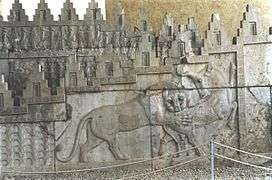 Bas-relief on the staircase of the palace.
Bas-relief on the staircase of the palace.
The Apadana Palace

Darius I built the greatest palace at Persepolis on the western side of platform. This palace was called the Apadana.[35] The King of Kings used it for official audiences. The work began in 518 BC, and his son, Xerxes I, completed it 30 years later. The palace had a grand hall in the shape of a square, each side 60 metres (200 ft) long with seventy-two columns, thirteen of which still stand on the enormous platform. Each column is 19 metres (62 ft) high with a square Taurus (bull) and plinth. The columns carried the weight of the vast and heavy ceiling. The tops of the columns were made from animal sculptures such as two-headed lions, eagles, human beings and cows (cows were symbols of fertility and abundance in ancient Iran). The columns were joined to each other with the help of oak and cedar beams, which were brought from Lebanon. The walls were covered with a layer of mud and stucco to a depth of 5 cm, which was used for bonding, and then covered with the greenish stucco which is found throughout the palaces.
Foundation tablets of gold and silver were found in two deposition boxes in the foundations of the Palace. They contained an inscription by Darius in Old Persian cuneiform, which describes the extent of his Empire in broad geographical terms, and is known as the DPh inscription:[36][37]
Darius the great king, king of kings, king of countries, son of Hystaspes, an Achaemenid. King Darius says: This is the kingdom which I hold, from the Sacae who are beyond Sogdia, to Kush, and from Sind (Old Persian: 𐏃𐎡𐎭𐎢𐎺, "Hidauv", locative of "Hiduš", i.e. "Indus valley") to Lydia (Old Persian: "Spardâ") - [this is] what Ahuramazda, the greatest of gods, bestowed upon me. May Ahuramazda protect me and my royal house!
— DPh inscription of Darius I in the foundations of the Apadana Palace[39]
At the western, northern and eastern sides of the palace, there were three rectangular porticos each of which had twelve columns in two rows of six. At the south of the grand hall, a series of rooms were built for storage. Two grand Persepolitan stairways were built, symmetrical to each other and connected to the stone foundations. To protect the roof from erosion, vertical drains were built through the brick walls. In the four corners of Apadana, facing outwards, four towers were built.
The walls were tiled and decorated with pictures of lions, bulls, and flowers. Darius ordered his name and the details of his empire to be written in gold and silver on plates, which were placed in covered stone boxes in the foundations under the Four Corners of the palace. Two Persepolitan style symmetrical stairways were built on the northern and eastern sides of Apadana to compensate for a difference in level. Two other stairways stood in the middle of the building. The external front views of the palace were embossed with carvings of the Immortals, the Kings' elite guards. The northern stairway was completed during the reign of Darius I, but the other stairway was completed much later.
The reliefs on the staircases allow one to observe the people from across the empire in their traditional dress, and even the king himself, "down to the smallest detail".[40]
- Ruins of the Apadana, Persepolis.
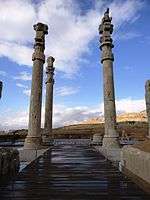 Ruins of the Apadana's columns.
Ruins of the Apadana's columns._(4688859421).jpg) Depiction of trees and lotus flowers at the Apadana, Persepolis.
Depiction of trees and lotus flowers at the Apadana, Persepolis._(4688678112).jpg) Depiction of figures at the Apadana.
Depiction of figures at the Apadana.
Apadana Palace coin hoard


The Apadana hoard is a hoard of coins that were discovered under the stone boxes containing the foundation tablets of the Apadana Palace in Persepolis.[36] The coins were discovered in excavations in 1933 by Erich Schmidt, in two deposits, each deposit under the two deposition boxes that were found. The deposition of this hoard is dated to circa 515 BCE.[36] The coins consisted in eight gold lightweight Croeseids, a tetradrachm of Abdera, a stater of Aegina and three double-sigloi from Cyprus.[36] The Croeseids were found in very fresh condition, confirming that they had been recently minted under Achaemenid rule.[41] The deposit did not have any Darics and Sigloi, which also suggests strongly that these coins typical of Achaemenid coinage only started to be minted later, after the foundation of the Apadana Palace.[41]
The Throne Hall
Next to the Apadana, second largest building of the Terrace and the final edifices, is the Throne Hall or the Imperial Army's Hall of Honor (also called the Hundred-Columns Palace). This 70x70 square meter hall was started by Xerxes I and completed by his son Artaxerxes I by the end of the fifth century BC. Its eight stone doorways are decorated on the south and north with reliefs of throne scenes and on the east and west with scenes depicting the king in combat with monsters. Two colossal stone bulls flank the northern portico. The head of one of the bulls now resides in the Oriental Institute in Chicago.[42]
At the beginning of the reign of Xerxes I, the Throne Hall was used mainly for receptions for military commanders and representatives of all the subject nations of the empire. Later, the Throne Hall served as an imperial museum.
Other palaces and structures
Other palaces included the Tachara, which was built under Darius I, and the Imperial treasury, which was started by Darius I in 510 BC and finished by Xerxes I in 480 BC. The Hadish Palace of Xerxes I occupies the highest level of terrace and stands on the living rock. The Council Hall, the Tryplion Hall, the Palaces of D, G, H, storerooms, stables and quarters, the unfinished gateway and a few miscellaneous structures at Persepolis are located near the south-east corner of the terrace, at the foot of the mountain.
Tombs

It is commonly accepted that Cyrus the Great was buried in Pasargadae, which is mentioned by Ctesias as his own city. If it is true that the body of Cambyses II was brought home "to the Persians," his burying place must be somewhere beside that of his father. Ctesias assumes that it was the custom for a king to prepare his own tomb during his lifetime. Hence, the kings buried at Naghsh-e Rostam are probably Darius I, Xerxes I, Artaxerxes I and Darius II. Xerxes II, who reigned for a very short time, could scarcely have obtained so splendid a monument, and still less could the usurper Sogdianus. The two completed graves behind the compound at Persepolis would then belong to Artaxerxes II and Artaxerxes III. The unfinished tomb, a kilometer away from the city, is debated to who it belongs.[43] It is perhaps that of Artaxerxes IV, who reigned at the longest two years, or, if not his, then that of Darius III (Codomannus), who is one of those whose bodies are said to have been brought "to the Persians." Since Alexander the Great is said to have buried Darius III at Persepolis, then it is likely the unfinished tomb is his.
Another small group of ruins in the same style is found at the village of Haji Abad, on the Pulvar River, a good hour's walk above Persepolis. These formed a single building, which was still intact 900 years ago, and was used as the mosque of the then-existing city of Estakhr.
Ancient texts
The relevant passages from ancient scholars on the subject are set out below:
- (Diod. 17.70.1-73.2) 17.70 (1) Persepolis was the capital of the Persian kingdom. Alexander described it to the Macedonians as the most hateful of the cities of Asia, and gave it over to his soldiers to plunder, all but the palaces. (2) It was the richest city under the sun, and the private houses had been furnished with every sort of wealth over the years. The Macedonians raced into it, slaughtering all the men whom they met and plundering the residences; many of the houses belonged to the common people and were abundantly supplied with furniture and wearing apparel of every kind....
- 72 (1) Alexander held games in honor of his victories. He performed costly sacrifices to the gods and entertained his friends bountifully. While they were feasting and the drinking was far advanced, as they began to be drunken, a madness took possession of the minds of the intoxicated guests. (2) At this point, one of the women present, Thais by name and Attic by origin, said that for Alexander it would be the finest of all his feats in Asia if he joined them in a triumphal procession, set fire to the palaces, and permitted women's hands in a minute to extinguish the famed accomplishments of the Persians. (3) This was said to men who were still young and giddy with wine, and so, as would be expected, someone shouted out to form up and to light torches, and urged all to take vengeance for the destruction of the Greek temples. (4) Others took up the cry and said that this was a deed worthy of Alexander alone. When the king had caught fire at their words, all leaped up from their couches and passed the word along to form a victory procession [epinikion komon] in honor of Dionysius.
- (5) Promptly, many torches were gathered. Female musicians were present at the banquet, so the king led them all out for the komos to the sound of voices and flutes and pipes, Thais the courtesan leading the whole performance. (6) She was the first, after the king, to hurl her blazing torch into the palace. As the others all did the same, immediately the entire palace area was consumed, so great was the conflagration. It was most remarkable that the impious act of Xerxes, king of the Persians, against the acropolis at Athens should have been repaid in kind after many years by one woman, a citizen of the land which had suffered it, and in sport.
- (Curt. 5.6.1-7.12) 5.6 (1) On the following day, the king called together the leaders of his forces and informed them that "no city was more mischievous to the Greeks than the seat of the ancient kings of Persia . . . by its destruction they ought to offer sacrifice to the spirits of their forefathers."...
- 7 (1) But Alexander's great mental endowments, that noble disposition, in which he surpassed all kings, that intrepidity in encountering dangers, his promptness in forming and carrying out plans, his good faith towards those who submitted to him, merciful treatment of his prisoners, temperance even in lawful and usual pleasures, were sullied by an excessive love of wine. (2) At the very time when his enemy and his rival for a throne was preparing to renew the war, when those whom he had conquered were but lately subdued and were hostile to the new rule, he took part in prolonged banquets at which women were present, not indeed those whom it would be a crime to violate, but, to be sure, harlots who were accustomed to live with armed men with more licence than was fitting.
- (3) One of these, Thais by name, herself also drunken, declared that the king would win most favor among all the Greeks, if he should order the palace of the Persians to be set on fire; that this was expected by those whose cities the barbarians had destroyed. (4) When a drunken strumpet had given her opinion on a matter of such moment, one or two, themselves also loaded with wine, agreed. The king, too, more greedy for wine than able to carry it, cried: "Why do we not, then, avenge Greece and apply torches to the city?" (5) All had become heated with wine, and so they arose when drunk to fire the city which they had spared when armed. The king was the first to throw a firebrand upon the palace, then the guests and the servants and courtesans. The palace had been built largely of cedar, which quickly took fire and spread the conflagration widely. (6) When the army, which was encamped not far from the city, saw the fire, thinking it accidental, they rushed to bear aid. (7) But when they came to the vestibule of the palace, they saw the king himself piling on firebrands. Therefore, they left the water which they had brought, and they too began to throw dry wood upon the burning building.
- (8) Such was the end of the capital of the entire Orient... .
- (10) The Macedonians were ashamed that so renowned a city had been destroyed by their king in a drunken revel; therefore the act was taken as earnest, and they forced themselves to believe that it was right that it should be wiped out in exactly that manner.
- (Cleitarchus, FGrHist. 137, F. 11 (= Athenaeus 13. 576d-e))
- And did not Alexander the Great have with him Thais, the Athenian hetaira? Cleitarchus speaks of her as having been the cause for the burning of the palace at Persepolis. After Alexander's death, this same Thais was married to Ptolemy, the first king of Egypt.
There is, however, one formidable difficulty. Diodorus Siculus says that the rock at the back of the palace containing the royal sepulchers is so steep that the bodies could be raised to their last resting-place only by mechanical appliances. This is not true of the graves behind the compound, to which, as F. Stolze expressly observes, one can easily ride up. On the other hand, it is strictly true of the graves at Naqsh-e Rustam. Stolze accordingly started the theory that the royal castle of Persepolis stood close by Naqsh-e Rustam, and has sunk in course of time to shapeless heaps of earth, under which the remains may be concealed.
Modern events
In 1971, Persepolis was the main staging ground for the 2,500 Year Celebration of the Persian Empire under the reign of the Pahlavi dynasty. It included delegations from foreign nations in an attempt to advance the Iranian culture and history.
The controversy of the Sivand Dam
Construction of the Sivand Dam, named after the nearby town of Sivand, began on 19 September 2006. Despite 10 years of planning, Iran's Cultural Heritage Organization was not aware of the broad areas of flooding during much of this time,[45] and there is growing concern about the effects the dam will have on the surrounding areas of Persepolis.
Many archaeologists worry that the dam's placement between the ruins of Pasargadae and Persepolis will flood both. Engineers involved with the construction deny this claim, stating that it is impossible, because both sites sit well above the planned waterline. Of the two sites, Pasargadae is considered the more threatened.
Archaeologists are also concerned that an increase in humidity caused by the lake will speed Pasargadae's gradual destruction. However, experts from the Ministry of Energy believe this would be negated by controlling the water level of the dam reservoir.
Museums (outside Iran) that display material from Persepolis
One bas-relief from Persepolis is in the Fitzwilliam Museum in Cambridge, England.[46] The largest collection of reliefs is at the British Museum, sourced from multiple British travellers who worked in Iran in the nineteenth century.[47] The Persepolis bull at the Oriental Institute is one of the university's most prized treasures, part of the division of finds from the excavations of the 1930s. New York City's Metropolitan Museum houses objects from Persepolis,[48] as does the Museum of Archaeology and Anthropology of the University of Pennsylvania.[49] The Museum of Fine Arts of Lyon[50] and the Louvre of Paris hold objects from Persepolis as well. A bas-relief of a soldier that had been looted from the excavations in 1935-36 and later purchased by the Montreal Museum of Fine Arts was repatriated to Iran in 2018, after being offered for sale in London and New York.[51]
- Forgotten Empire Exhibition, the British Museum.
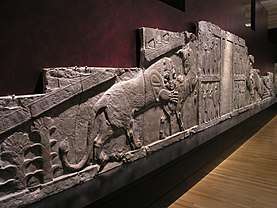 Forgotten Empire Exhibition, the British Museum.
Forgotten Empire Exhibition, the British Museum.- Persepolitan rosette rock relief, kept at the Oriental Institute.
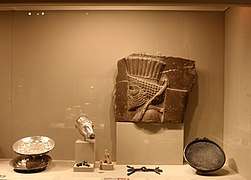 Achaemenid objects at the Metropolitan Museum of Art, New York, including a bas relief from Persepolis.
Achaemenid objects at the Metropolitan Museum of Art, New York, including a bas relief from Persepolis.
General views
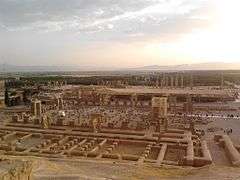 A general view of the ruins at Persepolis.
A general view of the ruins at Persepolis..jpg) A general view of the ruins at Persepolis.
A general view of the ruins at Persepolis..jpg) A general view of the ruins at Persepolis.
A general view of the ruins at Persepolis..jpg) A general view of the ruins at Persepolis.
A general view of the ruins at Persepolis.
See also
- Persepolis F.C.
- Palace of Darius in Susa, similar structure built at the same time
- Achaemenid architecture
- Naqsh-e Rustam
- Pasargadae
- Behistun Inscription
- Istakhr
- Qadamgah (ancient site)
- Cities of the Ancient Near East
- Persepolis (comics)
- Tachara
Notes
References
![]()
- Google maps. "Location of Persepolis". Google Maps. Retrieved 24 September 2013.
- UNESCO World Heritage Centre (2006). "Pasargadae". Retrieved 26 December 2010.
- Bailey, H.W. (1996) "Khotanese Saka Literature", in Ehsan Yarshater (ed), The Cambridge History of Iran, Vol III: The Seleucid, Parthian, and Sasanian Periods, Part 2 (reprint edition), Cambridge: Cambridge University Press, p. 1230.
- Michael Woods, Mary B. Woods (2008). Seven Wonders of the Ancient Middle East. Twenty-First Century Books. pp. 26–8. ISBN 9780822575733.
Persepolis means.
- Shahbazi, A. Shapur; Bosworth, C. Edmund (15 December 1990). "CAPITAL CITIES – Encyclopaedia Iranica". Encyclopædia Iranica. IV. pp. 768–774.
- Holland, Tom (August 2012). In the Shadow of the Sword. Little, Brown. pp. 118–122. ISBN 978-1408700075.
- Perrot, Jean (2013). The Palace of Darius at Susa: The Great Royal Residence of Achaemenid Persia. I.B.Tauris. p. 423. ISBN 9781848856219.
- Garthwaite, Gene R. (2008). The Persians. John Wiley & Sons. p. 50. ISBN 9781405144001.
- 2002. Guaitoli. M.T., & Rambaldi, S. Lost Cities from the Ancient World. White Star, spa. (2006 version published by Barnes & Noble. Darius I founded Persepolis in 500 BC as the residence and ceremonial center of his dynasty. p. 164
- "Persepolis". Encyclopedia Britannica.
- Mousavi, Ali, Persepolis: Discovery and Afterlife of a World Wonder, p. 53, 2012, Walter de Gruyter, ISBN 1614510334, 9781614510338, google books
- "Persepolis". toiran.com. Archived from the original on 5 February 2015. Retrieved 2 January 2015.
- Sachau, C. Edward (2004). The Chronology of Ancient Nations. Kessinger Publishing. p. 484. ISBN 978-0-7661-8908-9. p. 127
- Anonimo (1974). Al-Beruni and Persepolis. Acta Iranica. 1. Leiden: Peeters Publishers. pp. 137–150. ISBN 978-90-04-03900-1.
- Wiesehöfer 10-11.
- Henkelman 2008:Ch 2.
- "Persepolis". Wondermondo. 13 February 2012.
- Mousavi, Ali (19 April 2012). Persepolis: Discovery and Afterlife of a World Wonder. Walter de Gruyter. ISBN 9781614510338.
- Murray, Hugh (1820). Historical account of discoveries and travels in Asia. Edinburgh: A. Constable and Co. p. 15.
- "Principal Navigations, Voyages, Traffiques and Discoveries of the English Nation, by Richard Hakluyt : chapter11". ebooks.adelaide.edu.au. Retrieved 3 July 2019.
- Tuplin, Christopher (31 December 2007). Persian Responses: Political and Cultural Interaction with(in) the Achaemenid Empire. ISD LLC. ISBN 9781910589465.
- Gouveia, António de (1611). Relaçam em que se tratam as Guerras e Grandes Victorias que alcançou o grande Rei da Persia Xá Abbas do grão Turco Mahometto, e seu filho Amethe: as quais resultaram das Embaixadas, que por mando da Catholica e Real Magestade del Rei D. Felippe segundo de Portugal fizeram alguns Religiosos da ordem dos Ermitas de S. Augustinho à Persia. Lisboa: Pedro Crasbeeck. pp. 31–32.
- C. Wade Meade (1974). Road to Babylon: Development of U.S. Assyriology. Brill Archive. pp. 5–7. ISBN 978-9004038585.
- M. H. Aminisam (2007). تخت جمشيد (Persepolis). AuthorHouse. pp. 79–81. ISBN 9781463462529.
- Ali Mousavi (2012). Persepolis: Discovery and Afterlife of a World Wonder. Walter de Gruyter. pp. 104–7. ISBN 9781614510284.
- Ali Mousavi, Persepolis in Retrospect: Histories of Discovery and Archaeological Exploration at the ruins of ancient Passch, Ars Orientalis, vol. 32, pp. 209-251, 2002
- "GODARD, ANDRÉ – Encyclopaedia Iranica". www.iranicaonline.org. Retrieved 3 July 2019.
- Ernst E Herzfeld, A New Inscription of Xerxes from Persepolis, Studies in Ancient Oriental Civilization, vol. 5, 1932
- Erich F Schmidt, Persepolis I: Structures, Reliefs, Inscriptions, Oriental Institute Publications, vol. 68, 1953
- Erich F Schmidt, Persepolis II: Contents of the Treasury and Other Discoveries, Oriental Institute Publications, vol. 69, 1957
- Erich F Schmidt, Persepolis III: The Royal Tombs and Other Monuments, Oriental Institute Publications, vol. 70, 1970
- Erich F Schmidt, The Treasury of Persepolis and Other Discoveries in the Homeland of the Achaemenians, Oriental Institute Communications, vol. 21, 1939
- Roaf, Michael; Boardman, John (1980). "A Greek painting at Persepolis". The Journal of Hellenic Studies. 100: 204–206. doi:10.2307/630751. JSTOR 630751.
- Pierre Briant (2002). From Cyrus to Alexander: A History of the Persian Empire. Eisenbrauns. pp. 256–8. ISBN 9781575061207.
- Penelope Hobhouse (2004). The Gardens of Persia. Kales Press. pp. 177–8. ISBN 9780967007663.
- Zournatzi, Antigoni (2003). "The Apadana Coin Hoards, Darius I, and the West". American Journal of Numismatics (1989-). 15: 1–28. JSTOR 43580364.
- Persepolis : discovery and afterlife of a world wonder. 2012. pp. 171–181.
- DPh - Livius.
- DPh inscription, also Photographs of one of the gold plaques
- Garthwaite, Gene R. (2008). The Persians. John Wiley & Sons. p. 50. ISBN 9781405144001.
- Fisher, William Bayne; Gershevitch, I.; Boyle, John Andrew; Yarshater, Ehsan; Frye, Richard Nelson (1968). The Cambridge History of Iran. Cambridge University Press. p. 617. ISBN 9780521200912.
- "Oriental Institute Highlights". Oi.uchicago.edu. 19 February 2007. Retrieved 30 December 2012.
- Potts, Daniel T (21 May 2012). A Companion to the Archaeology of the Ancient Near East. ISBN 9781405189880.
- XPc inscription
- Vidal, John (23 December 2004). "Dam is threat to Iran's heritage". the Guardian. Retrieved 10 June 2018.
- A Persepolis Relief in the Fitzwilliam Museum, Cambridge. Richard Nicholls and Michael Roaf. Iran, Vol. 15, (1977), pp. 146-152. Published by: British Institute of Persian Studies.
- Allen, Lindsay (1 January 2013). ""Come Then Ye Classic Thieves of Each Degree": The Social Context of the Persepolis Diaspora in the Early Nineteenth Century". Iran. 51 (1): 207–234. doi:10.1080/05786967.2013.11834730. ISSN 0578-6967.
- Harper, Prudence O., Barbara A. Porter, Oscar White Muscarella, Holly Pittman, and Ira Spar. "Ancient Near Eastern Art." The Metropolitan Museum of Art Bulletin, v. 41, no. 4 (Spring, 1984).
- Relief said to be from Persepolis. Penn Museum Collections.
- (in French) Musée des Beaux-Arts de Lyon website
- Mashberg, Tom (23 July 2018). "Judge Orders Return of Ancient Limestone Relief to Iran". The New York Times. ISSN 0362-4331. Retrieved 3 July 2019.
Further reading
- Curtis, J. and Tallis, N. (eds). (2005). Forgotten Empire: The World of Ancient Persia. University of California Press. ISBN 0-520-24731-0.
- Wilber, Donald Newton. (1989). Persepolis: The Archaeology of Parsa, Seat of the Persian Kings. Darwin Press. Revised edition ISBN 0-87850-062-6.
External links
- Persepolis official website Persepolis official website
- Persepolis at the Ancient History Encyclopedia with timeline, illustrations, and books
- Arthur John Booth The Discovery and Decipherment of the Trilingual Cuneiform Inscriptions 1902
- Persepolis Photographs and Introduction to the Persian Expedition,
- 360 degrees panorama gallery of Persepolis
- Google Maps
- "Persepolis" at Cultural Heritage Organization of Iran
- Greek Art And Arch itecture In Iran (Mentions Ionian work in Persepolis)

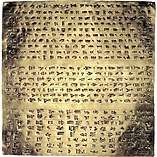

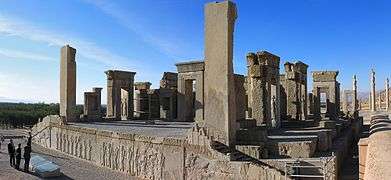
.jpg)

